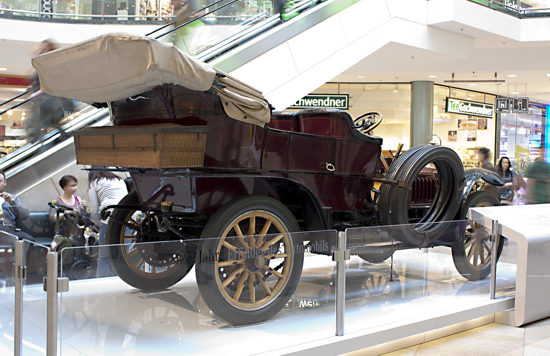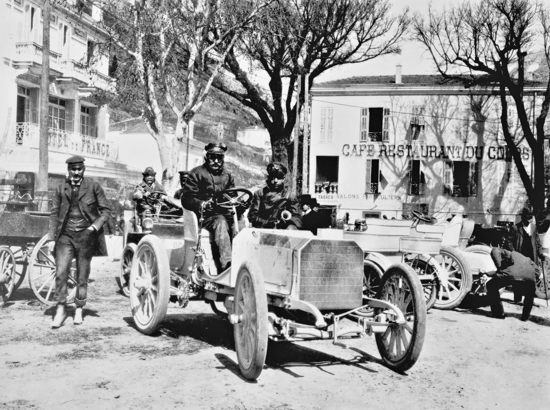 |
| Mercedes logo 1902 |
German name: "Mercedes 35 PS" (35 Pferdestärke)
English name: "Mercedes 35 HP" (35 horsepower)
English name: "Mercedes 35 HP" (35 horsepower)
Category: Cars
Subcategory: Torpedo
Designers: Wilhelm Maybach, Paul Daimler
Producer: Daimler Motoren Gesellschaft (founded by Wilhelm Maybach and Paul Daimler in 1890)
Features: Its front-mounted four-cylinder in-line engine was bolted directly to the new, pressed-steel frame and had the sensational output of 35 hp (26 kW). The engine speed was regulated between 300 and 1000 rpm by a lever on the steering wheel. The cylinders and cylinder head formed a single unit, and for the first time the crankcase was made of aluminum. The power-to-weight ratio was now only 6.6 kilograms per horsepower, and one year later it fell to just 4.6 kg/hp. The intake valves were no longer controlled automatically, but by camshaft, like the exhaust valves. The car featured a spray-nozzle carburetor, honeycomb radiator, cooling fan, gear-type oil pump, water pump and magneto ignition. Equally new features of the car included a very compact, self-adjusting spring-band clutch, a single gearshift lever moving in a gate to operate the four-speed transmission, and a heavily inclined steering column. The significantly longer wheelbase, wider track and wheels of virtually equal size on both axles gave the car a high level of handling stability. The brakes were matched to the raised engine performance. The Mercedes was fitted with 30 centimeter wide drum brakes on the rear wheels, operated via a linkage by a manual lever. The foot-operated service brake acted on the drive shaft.
Interesting facts: The Mercedes 35 HP (German: Mercedes 35 PS) was designed in 1901 by Wilhelm Maybach and Paul Daimler, for Emil Jellinek. Emil Jellinek was a wealthy Austrian businessman and Austro-Hungarian diplomat living in Nice on the French Riviera. His daughter Adriana Manuela Ramona Jellinek, 10 years old at the car's construction, was given the pet name "Mercédès". Jellinek used to name his possessions after her, such as his mansions, the automobiles he sold, his racing car team, etc.
Property: Daimler AG
Producer website: http://www.daimler.com
 |
| Mercedes 35 PS (passenger side) |
 |
| Mercedes 35 PS (front) |
 |
| Mercedes 35 PS (driver side) |
 |
| Mercedes 35 PS (back) |
 |
| Mercedes 35 PS at the Nice-La Turbie races (March 25-29, 1901). At Nice Week works driver Wilhelm Werner pilots his 35 hp Mercedes to victory in the 392-km Nice - Salon - Nice race. Werner also wins the Nice - La Turbie hillclimb at an average speed of 51.4 km/h. This picture shows Baron Henry de Rothschild's 35-hp Mercedes Simplex racing car during the Nice-La Turbie hillclimb, March 29, 1901. At the wheel Wilhelm Werner, who was to become the Kaiser's driver. |
 |
| Mercedes 35 PS at the third Semmering Race (September 22, 1901). Driving a 35 hp Mercedes, Dr Richard Ritter von Stern takes first place overall in the third Semmering Race to win the Challenge Trophy of the Austrian Automobile Club, endowed by Theodor Dreher. |
 |
The first Mercedes model implementers Left: Wilhelm Maybach (Heilbronn, February 9, 1846 - Stuttgart, December 29, 1929), engineer.Center: Paul Daimler (Karlsruhe, September 13, 1869 - Berlin, December 15, 1945), engineer. Right: Emil Jellinek (Leipzig, April 6, 1853 - Genève, January 21, 1918), entrepreneur. |
 |
| Mercedes-Benz C-Class, the best-selling Mercedes line ever (here in 2019) |



